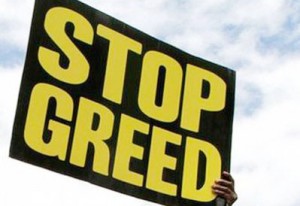 Unveiling the 2016 TI report at a Maputo press conference on Wednesday, Baltazar Fael, a researcher at the Centre for Public Integrity (CIP), the Mozambican chapter of TI, noted that Mozambique’s classification in the index had not shifted very much in the previous four years – it had been ranked in 123rd position in 2012, 119th in both 2013 and 2014, rising to 112th in 2015.
Unveiling the 2016 TI report at a Maputo press conference on Wednesday, Baltazar Fael, a researcher at the Centre for Public Integrity (CIP), the Mozambican chapter of TI, noted that Mozambique’s classification in the index had not shifted very much in the previous four years – it had been ranked in 123rd position in 2012, 119th in both 2013 and 2014, rising to 112th in 2015.
But in the 2016 index, Mozambique fell by 32 places, a decline that Fael described as “unprecedentedâ€. Mozambique had the sharpest fall in the index of any country.
For this year’s index TI researched 177 countries, giving each of them a score depending on the perception of public sector corruption. The higher the score, the cleaner a country is considered. Regarded as the least corrupt countries in the 2016 index are Denmark and New Zealand, each with a score of 90, Finland (89) and Sweden (88).
At the other end of the index, the most corrupt country is one which barely has a state at all – Somalia, with a score of 10. It is followed by South Sudan (11), North Korea (12) and Syria (13).
Mozambique’s score used to be fairly steady – 31 in 2012, 30 in 2013, and 31 in 2014 and 2015. But in the latest report, it has tumbled to 27, tying with Guinea-Conakry and Mauretania, and one point above Bangladesh.
Fael attributed Mozambique’s fall down the index partly to the scandal of the “hidden debtsâ€. These are the government-guaranteed loans to the security-related companies Proindicus and MAM (Mozambique Asset Management), amounting to a total of over 1.1 billion dollars. The managing director of the International Monetary Fund (IMF), Christine Lagarde, publicly described these undisclosed loans as an example of corruption, and they led the IMF, and Mozambique’s other western partners, to suspend financial cooperation with the government.
Other factors possibly involved in Mozambique’s low ranking are scandals involving large bribes from Brazilian companies. Thus last year the Brazilian aircraft manufacturer, Embraer, was fined 225 million US dollars by the American and Brazilian authorities for offering bribes in four countries, including Mozambique.
The Mozambican case involved a bribe of 800,000 dollars to sweeten the purchase of two Embraer aircraft by Mozambique Airlines (LAM). Documents from the Brazilian federal prosecution service name two Mozambican officials involved in receiving this money, the former chairperson of LAM, Jose Viegas, and Mateus Zimba who, at the time, was the director of the Mozambican operations of the South African petrochemical giant, Sasol.
The Brazilian construction company, Odebrecht, confessed to an international network of bribery, including a 900,000 dollar bribe in Mozambique. To date the names of those who received this bribe have not been revealed.
While some countries involved in the scandal moved promptly against Odebrecht, the Mozambican authorities have so far done nothing. Both the Peruvian and the Panamanian authorities decreed that Odebrecht could no longer bid for international tenders in their countries. Fael said there is nothing to prevent Mozambique acting likewise and putting Odebrecht on a black list.
CIP argues that the weakness of the Mozambican courts and prosecution services in dealing with corruption cases also contributes to Mozambique’s poor showing on the TI index.
Fael argued that the “strong links†between the judiciary and the executive lead to situations of impunity when dealing with large scale corruption. He claimed that “the independence of the judiciary is merely formal, and the autonomy of the Public Prosecutor’s Office is very tenuousâ€.
In an earlier repot on the costs of corruption, CIP had warned that, between 2002 and 2014, corruption had cost the Mozambican economy over 4.8 billion dollars. In 2014 alone, corruption had led to the loss of investment projects valued at 90 million dollars. It had increased the costs of production and damaged the competitiveness of the Mozambican private sector.
CIP blamed corruption for crowding out clean foreign investors in favour of investors with a dubious reputation. It also damaged Mozambique’s reputation as a destination for foreign direct investment.
Eight of the other members of the Southern African Development Community (SADC), score better than Mozambique on the TI index, and only four score worse.
The list of SADC members, according to their positions on the index, is as follows:
- Botswana (35th position, score of  60)
- Mauritius (50th, score of 54)
- Namibia (53rd, score of 52)
- South Africa (67th, score of 45)
- Lesotho (86th, score of 39)
- Zambia (89th, score of 38)
- Tanzania (119th, score of 32)
- Malawi (122nd, score of 31)
- Mozambique (144th, score of 27)
- Madagascar (150th, score of 26)
- Zimbabwe (155th, score of 22)
- Democratic Republic of Congo (157th, score of 21)
- Angola (164th, score of 18)
Two SADC members, Swaziland and Seychelles, are not included in the TI index.
Post published in: Africa News

